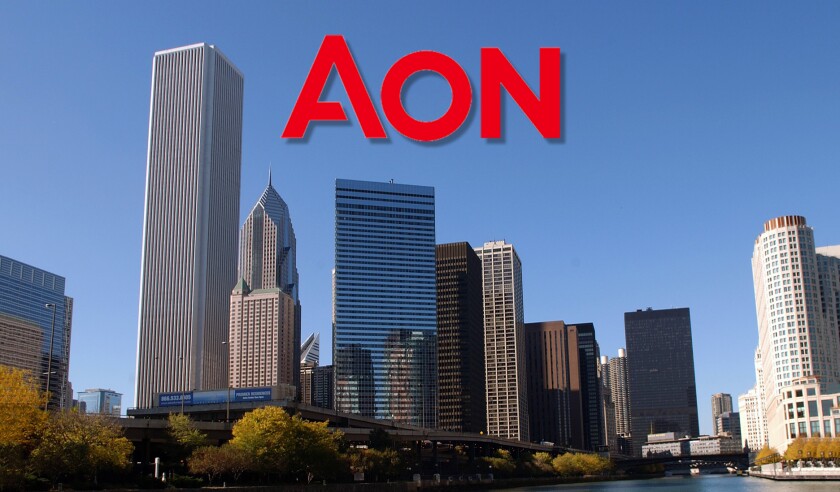After the so-called 3x3 strategy was unveiled, which will involve a roughly $900mn charge, the long-serving Aon CEO said: “This is about a set of actions over the next three years which substantially accelerate progress and put us in a position to continue building momentum.”
He continued: “Exceptional financial performance will come from delivery of these three commitments as a derivative outcome, not as the primary focus.”
Driving increased margins over time creates more operating leverage in the business, he noted. “The outcome of that is an evolving capital application around the world that’s different than what we have now. It opens up the ability to think about capital more broadly.”
He was understandably close-lipped about what this might mean in practice, but it seems to be a tacit acknowledgement that the firm is now potentially a buyer of broking assets at scale, rather than being primarily a buyer of its own stock.

Case emphasised that the strategy has emerged from the escalation of the forces which shaped its 2010 Aon United strategy, with the world becoming riskier.
He said there has been “a profound set of transitions that require a big set of answers” – pointing to increased geopolitical tensions, Covid-19 and its impact on workforce questions, climate change and disruption to established trade patterns.
This is a threat to industry relevance, he added. “To reduce that trend is going to need a meaningful set of integrated views to help clients. And these are the forces that really set up the industry’s battle for relevance.”
“We could have just kept on our current path and made progress every year, but we decided to go further, faster,” he said, adding that it will focus on scaling its existing strategy to deliver improved client leadership, service experience and increased innovation.
Case addressed the escalating challenges in property cat and mounting concern in some corners of the industry around US casualty loss cost inflation. “And the problem is that’s not a total cost of risk problem, that’s a return on capital problem – and so it’s going to go beyond the risk buyer.”
“They’re going down the hall to talk to the treasurer and the CFO. It’s a different conversation and that’s why you have to come back with an integrated set of solutions. That isn’t just ‘here’s your placement’ – it really is connecting risk to capital.”
He predicted that the pressure these changes are creating will only become more intense in the coming years.
The building blocks
The company would not state it this way, but the essence of the 3x3 plan is that it will take Aon and make it even more Aon.
Aon has been charting a distinctive course over the last decade or more, which has made it an outlier on company structure, capital deployment, new product development, analytics investment and headcount growth (or relative lack thereof). It has also helped catapult the firm to remarkable financial performance, which in turn has driven major stock appreciation.
This plan is based around the intent to take the things that are distinctive about the firm today and intensify them.
First, it will look to build a more unified firm with stronger connectivity – furthering the work already undertaken to break down the dividing lines between commercial risk, reinsurance, health, benefits, wealth and talent. This can be traced back to moves that started in 2010, with its Aon United programme.
Second, more of the firm’s clients will be transitioned to a single point of contact with Aon, working with client executives that are expected to be across the whole range of capabilities. (This “enterprise client” approach was rolled out for Aon’s largest 400 clients over the last couple of years.)
Third, the firm will look to roll out the next iteration of 2017-creation Aon Business Services, a unit with 15,000 staff that will act not just as an integrated back/middle office, but also as an analytics hub. Here again, Aon is seeking more integration around a business services and analytics platform that will create leverage, support new product development and supercharge margins.
“Certain segments might become attractive to us”
Aon has been a major margin story over the last decade or more, driving a roughly 1100 bps improvement in operating margin, and Case stressed that one of the derivative financial impacts of the new plan would be additional margin growth.
However, the margin growth does not reflect extracting additional economics for shareholders, he said. “When we create new value for clients, we’re also creating value for our shareholders.”
Referencing the creation of a parametric bond for a tech company that pays out to their staff in case of a hurricane, Case argues this type of content and capability changes the calculus on value for clients and shareholders, “because we have a better, more valuable answer”.
Alongside the impact of increased operating leverage, Case stressed that the end of “free money” had changed market dynamics. “So certain segments might become attractive to us that weren’t attractive before.”
Case declined to address prior reporting from this publication that Aon has stepped up its search for an acquisition or acquisitions that will allow it to enter the US mid-market and US wholesale segments.
However, he argued that the central reasons for the 3x3 plan were client-related. “Most importantly of all, by doing this, we are going to have tools and capabilities with our clients that we think they need and are unique,” he said.
Case expanded on the potential for margin expansion created by the project on the firm’s Q3 earnings call.
“When you think about the margin… it's almost like it's treated like a zero-sum game, the split between clients and colleagues and shareholders,” he explained.
“We don't see it that way. We see it around value. We provide incremental value. We obviously get compensated for that. That contribution is really what drives margin over time. So greater value means more margin.”
End margin game
The roughly $900mn charge over three years to deliver this is eye-catching, but it’s less than 10% of projected free cashflow. Indeed, with $350mn of projected annual cost savings by 2026, the ratio of costs to savings looks conservative at 2.6:1, or as if the spend skews heavily to technology investment. (The company declined to provide any breakdown on its earnings call.)
There are no numbers on future margin expansion, but the past roughly 90 bps a year seems to be the baseline the company is working towards. There are question marks around what a terminal margin might be, but it's clear that Aon doesn’t think the 34%-35% this would take them to by 2026 to is the top of the mountain.
How close it can creep towards 40% over the next decade remains to be seen. The firm clearly intends to test the premise that technology, process and structure allow you to leverage headcount much more efficiently than in the past.
Aon stresses that it is being hurried along in these planned changes by a combination of client need and secular forces.
Crucially, however, it is also trying to invest to build the infrastructure that would put it in a position to deploy technology at scale. In this regard, it is watching the development of generative AI and trying to give itself the option of using it as a transformational tool.
Aon has not been light on strategy or transformation during Case’s 18-year tenure as CEO. However, this is the first time it has chosen to put in place a multi-year strategy.
Codifying the different strands of strategy in a three-year plan makes sense, given that Aon has moved past that initial period of refocusing following the Willis breakup, and given the intensification of the disruptive forces that are shaping the approach.
It also makes sense though from an investor-relations perspective. Providing some fresh framing and a clear narrative to investors may help address the share price, which is lagging this year versus Marsh McLennan (+1% through 27 October, vs +11%), likely owing to the organic growth delta.
The growth gap has been evident for much of the last year, and this quarter Marsh McLennan was at 10%, ahead of Aon’s 6% - although the delta is magnified by the lack of fiduciary income in Aon’s number.


